8 Major Ports of Marshall Islands
Marshall Islands is an island nation in Micronesia, in the northwestern Pacific Ocean. It comprises 29 coral atolls and five islands divided across 2 island chains called the Ratak and the Ralik.
These islands have limited natural resources, and the imports exceed the exports. Produce such as coconuts. Melons, taro, tomatoes, fruits, chickens and pigs are exported. The industrial sector mainly produces copra, manufactures crafts, and processes fish, especially tuna.
Coming to its shipping sector, the Marshall Islands is a flag of convenience, and as of 2017, its ship registry was the 2nd biggest in the world after Panama. The islands have many small and big ports that will be discussed in this article.
1. Port of Majuro
It lies to the east of the Marshall Islands, at the southern part of the Ratak Chain. The atoll has over 50 coral islands on a reef surrounding a big lagoon.
Most of these islands are 1.5 m high, apart from the western end of Majuro Island, which extends 14 nautical miles along the southwestern side of the atoll, which is 5 m high.
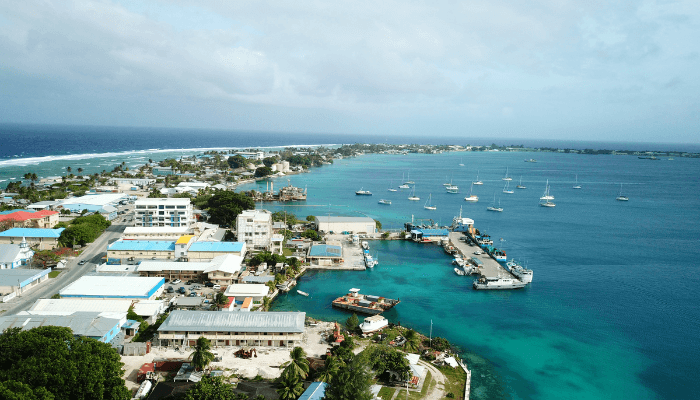
Dalap, Djarrit and Uliga islands are connected to each other via a causeway located on the eastern end of the atoll. Most activities centre on these three islands.
The Majuro Commerical Dock at the southeastern end of the Atoll handles containers, general cargo, oil tankers and cruise ships. Around 70 to 80 ships visit this dock annually. The biggest vessel ever handled at this facility is the USS Boxer, with a 257 m LOA, 42.3 m beam and a draught of 8.1 m.
The Port of Majuro has two facilities- the Delap Dock Port and the Uliga Dock.
2. Port of Delap Dock
The main international cargo port of the Republic of Marshall Islands, Delap Dock, lies in the Majuro Atoll and has a cargo handling area, a container freight station, an equipment repair shop, and also the port authority’s offices for supporting the processing and storage of cargo and containers.
Delap’s wharf is 308 m long and 30 m wide. Close to it is the container yard spanning 6.398 acres, with a base of crushed coal with many power connections for reefers.
The entrance to the Majuro Atoll is via Calalin Channel, which is 450 m wide and 12 nautical miles to the port, with depths ranging from 20 to 60 m.
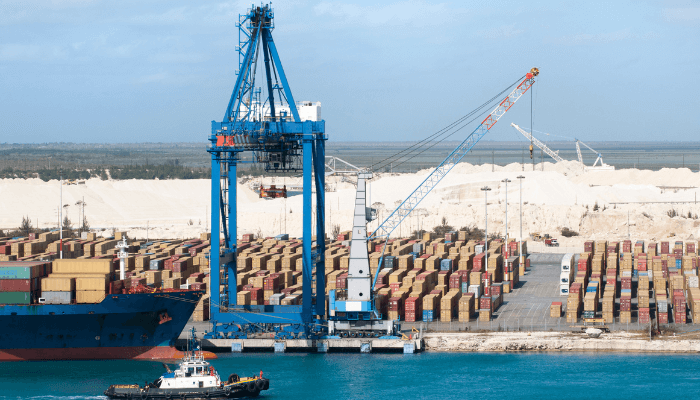
Several Aids to Navigation mark the channel and the harbour area; however, most require immediate maintenance. Here is a lighthouse on Eroj Island just at the channel entrance to assist ships in getting into the Calalin Channel. It is also lined with 6 different lighted markers that outline the channel’s limits and direct ships safely into the Majuro Lagoon.
The Port has a Main Delap Dock on the southeastern side of Majuro Lagoon, which extends east to west around 308 metres. The Delap East Dock lies on the eastern side of the port and is used by interisland cargo ships for unloading copra to the Tobolar coconut processing operation.
The east dock stretches 80 m north to the south. The West Dock is situated on the western side of the main dock and stretches 58 m to the south.
The port handles a variety of imported food products, household items, materials, diesel and jet fuels, refined gasoline products, copra, coconut oil, etc. It also handles vehicles, LPG, breakbulk, containers, vehicles and fish. Fish is transhipped from here after being loaded into reefers for export.
International fishing vessels also berth at this port occasionally for maintenance, repair, and fuel resupplies.
Port of Delap Dock handles about 2500 TEUs annually with eight scheduled freight vessel services monthly. This number has reduced to 1300 TEUs after COVID-19. However, it is gradually going to pre-pandemic levels. Container unloading is carried out by the ship, and port handling is done by reach loaders. Container ships and tankers are prioritised, followed by fishing vessels.
The port is fenced, and there is a power station and a tank farm in the vicinity with privately owned wharves, residences, and warehouses. There is also a bulk liquid pumping station, and it is used to receive diesel fuel from tankers at the Delap berth and to bunker the small vessels with diesel fuel.
3. Uliga Dock
The primary domestic port facility in Majuro, Uliga Dock, is the key point for cargo shipments to the outer island. It also serves as the base for the Marshall Islands Shipping Corporation or MISCO.
MISCO has 4 cargo-passenger vessels that offer services to the outer islands. However, it offers only 4 services annually along a northern, southern, eastern and western route.
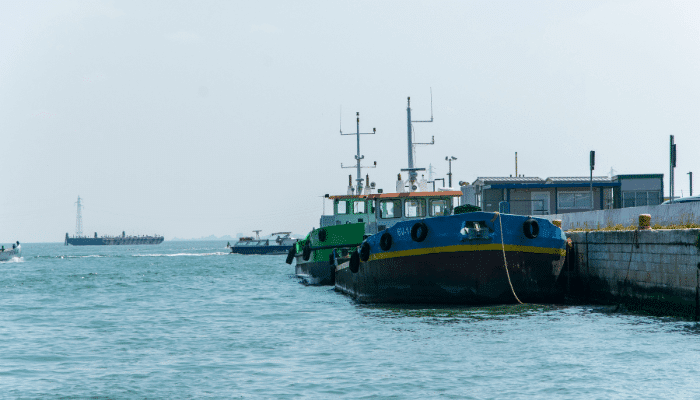
Uliga Dock is used for inter-island passenger services, trading and supporting government vessels. It comprises an L-shaped dock near the port fairway and a warehouse. It is 115 m long and has a 12 m draft. This dock also handles break bulk cargo destined for the outer islands. All vessels are self-loaded, and fuel is available at the dock.
MISCO operates a warehouse which is used to store domestic cargo. There is a 200 m2 yard for keeping containers, too.
4. Port of Kwajalein
Kwajalein Atoll lies in the Pacific Ocean and houses the Ronald Reagan Ballistic Missile Defense Test Site, which is managed by the U.S. military. The port is a major logistical hub for military activities here.
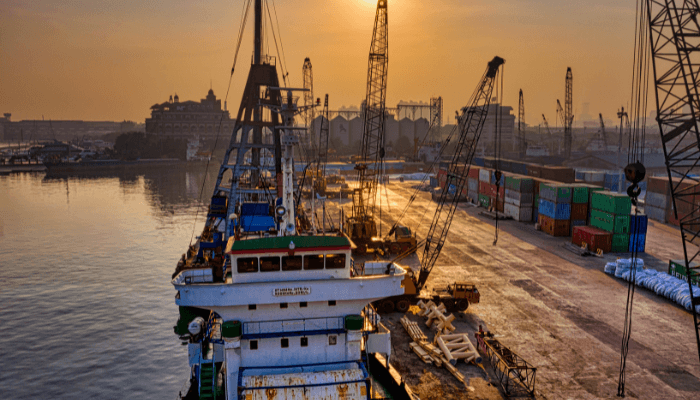
There are several oil and water tanks, an airfield and other installations on the island. It is a crucial base for the U.S, mainly for testing and tracking missiles and other defensive systems. It also supports other activities of the U.S. military; hence, it is important for handling supplies, equipment and personnel that reach the atoll. It is a logistical centre which facilitates the movement of essential supplies like fuel, food, water and equipment.
It has many warehouses, piers and docks for loading and unloading cargo. Access to the port is limited and under strict security surveillance due to its military importance.
5. Ebeye Port
This international port in Kwajalein Atoll handles 700 TEUs every year. Inter-island ferry services ply from this facility, which handles containers, general cargo and fuel.
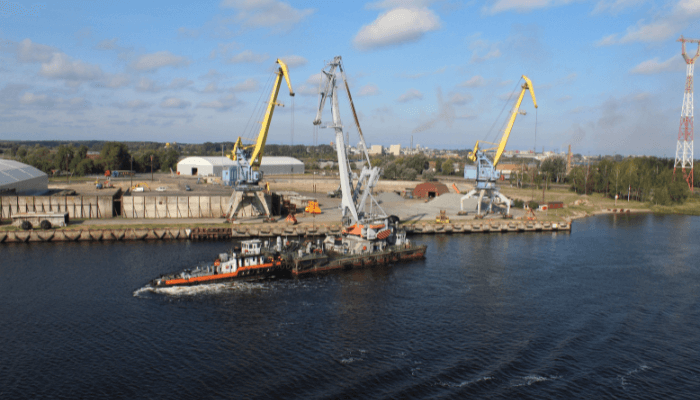
The wharf is 120 m long and 36.5 m wide, while the container yard is 4380 square m. A small L-shaped pier to the northern side accommodates ships and ferries from Kwajalein.
Water depth to the wharf’s western side varies from 12 to 17 m. The Ebye dock has basic handling equipment, and there is a RORO landing 500 m north of the main dock, close to a gas station. It is 35 m wide and welcomes RORO vessels and landing crafts.
6. Jaluit Atoll
Jaluit Atoll lies in the Marshall Islands, and the Port of Jaluit has been an important port since the German colonial era. It was an important centre of administration during the Japanese mandate period and throughout the World War period.
Jaluit Port was the key point of trade, shipping and administration. It was a centre for copra production, and vessels would frequent the port, especially during the copra boom of the 19th and 20th centuries.
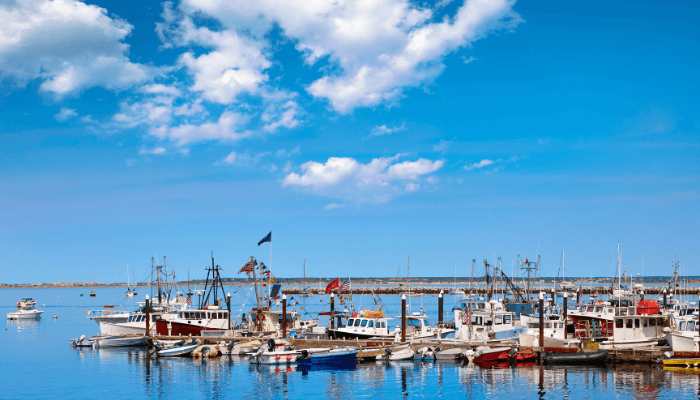
When the Japanese administration’s headquarters were in Jaluit, many buildings and military installations came up, and the Jaluit port handled military supplies, too. After the Second World War, the U.S. took control of the Marshall Islands and used Jaluit as their administrative centre till the 1950s.
Today, the Jaluit Port is not the bustling centre of trade that it once was, yet it is a connecting point for inter-island travel within the Marshall Islands. Many come here for its history and culture, the Second World War remains, and to observe the traditional way of life of the locals. Jaluit faces challenges due to rising sea levels that have impacted low-lying atolls.
7. Wake Island Port
Also referred to as the U.S Minor Outlying Island, Wake Island comes under the jurisdiction of the U.S Air Force and is administered by the Commander of Wake Island Air Force Base.
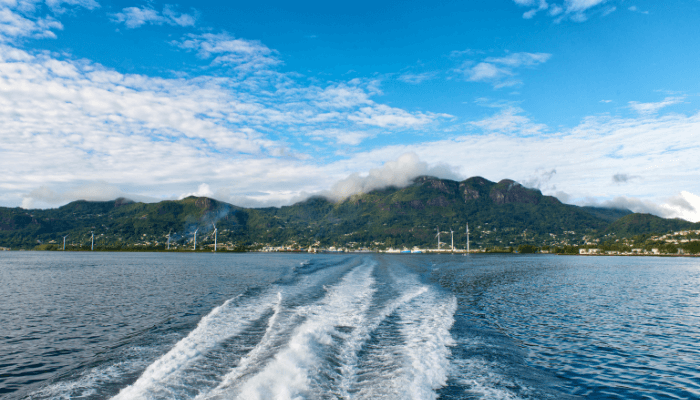
It consists of 3 different islands, namely Wake, Peale and Wilkes, which form the atoll. The northwest side of it has a barrier reef that prevents entry into the lagoon. Due to the reefs, there are just 2 offshore anchorages for ships carrying essential supplies.
8. Wotje Port
The Wotje Atoll does not have a major port with extensive infrastructural facilities. However, it does support maritime activities. It served as a military base during the Second World War and was later used to transport copra produced here.
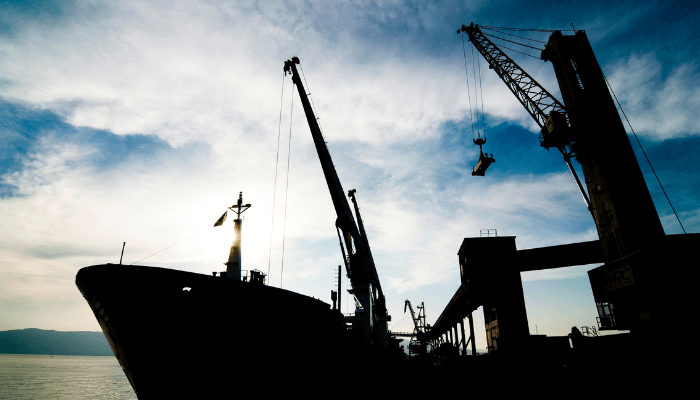
Activities here are limited to small-scale operations like fishing, inter-island transport using small boats and some basic docking facilities for smaller craft.
You might also like to read-
- 15 Not-So-Known Facts about the Indian Ocean
- 15 Amazing Facts About Coral Reefs
- 10 Major Facts About Sulu Sea You Must Know
- 10 Marine Biome Facts You Must Know
- 10 Facts About The Laccadive Sea
Disclaimer :
The information contained in this website is for general information purposes only. While we endeavour to keep the information up to date and correct, we make no representations or warranties of any kind, express or implied, about the completeness, accuracy, reliability, suitability or availability with respect to the website or the information, products, services, or related graphics contained on the website for any purpose. Any reliance you place on such information is therefore strictly at your own risk.
In no event will we be liable for any loss or damage including without limitation, indirect or consequential loss or damage, or any loss or damage whatsoever arising from loss of data or profits arising out of, or in connection with, the use of this website.
Do you have info to share with us ? Suggest a correction
Disclaimer :
The information contained in this website is for general information purposes only. While we endeavour to keep the information up to date and correct, we make no representations or warranties of any kind, express or implied, about the completeness, accuracy, reliability, suitability or availability with respect to the website or the information, products, services, or related graphics contained on the website for any purpose. Any reliance you place on such information is therefore strictly at your own risk.
In no event will we be liable for any loss or damage including without limitation, indirect or consequential loss or damage, or any loss or damage whatsoever arising from loss of data or profits arising out of, or in connection with, the use of this website.

About Author
Zahra is an alumna of Miranda House, University of Delhi. She is an avid writer, possessing immaculate research and editing skills. Author of several academic papers, she has also worked as a freelance writer, producing many technical, creative and marketing pieces. A true aesthete at heart, she loves books a little more than anything else.
Latest Maritime Knowledge Articles You Would Like:
Subscribe To Our Newsletters
By subscribing, you agree to our Privacy Policy and may receive occasional deal communications; you can unsubscribe anytime.















